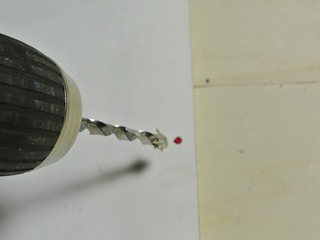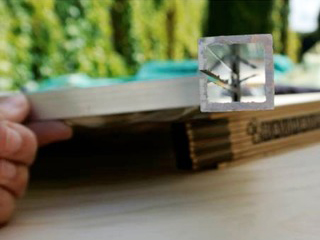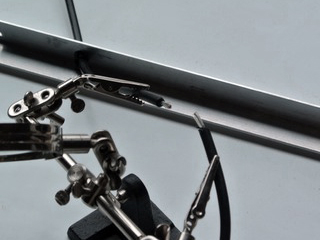Matériaux
- 6 x Hinges, 24mm (l) x 20mm (w) x 1mm (th)
- 4 x L-Aluminium profile, 558mm (l) x 20mm (w) x 2mm (th)
- 4 x Squared aluminium profile (better rectangular profiles with 20mm x 8mm), 150mm (l) x 20mm (w) x 2mm (th)
- 4 x T-Aluminium profiles, 560mm (l) x 15mm (w) x 15mm (h)x 2mm (th)
- 4 x T-Aluminium profiles, 435mm (l) x 15mm (w) x 15mm (h)x 2mm (th)
- 2 x L-Aluminium profiles, 545mm (l) x 15mm (w) x 15mm (h)x 2mm (th)
- 4 x L-Aluminium profiles, 420mm (l) x 15mm (w) x 15mm (h)x 2mm (th)
- 24 x Hexagonal bolts, M3 x 8mm (l)
- 24 x washers, M3
- 24 x Self-locking nuts, M3
- 36 x Countersunk bolts, M5 x 10mm (l)
- 36 x Self-locking nuts, M5
- 36 x washers, M5
- 8 x Wing bolts, M6 x 20mm (l)
- 4 x Semi-flexible mono-crystalline PV-modules, in this case, we've used the SUPERFLEX SGM-FL-35W, 12 V, 35 Wp
For cables:
- 1 x Female M4-plug
- 1 x Male M4-plug
- 3 x Heat shrink tubes (short), for 4 mm² cables
Outils
Étape 1 - Drill the PV-module needs
You can find the positions and diameter of the holes in the .PDF technical drawing which you can download below. For marking those of the PV-modules use a marker pen. For drilling use a metal or wood drill. Two of the 20mm-L-profiles need to have a slot cut along one side; the position of the slots is shown in the .PDF technical drawing downloadable below. These slots will allow the angle of incidence can be adjusted. To slot the profile you should use a milling cutter.
Étape 2 - Connect the profiles on the backside of the modules
After drilling, connect the profiles on the backside of the modules with the M5-10mm countersunk bolts, nuts and washers. Take care to place the washer on the side of the nut.
Étape 5 -
When the panel assembly is unfolded, it is held open and flat using the 15 cm long squared aluminium profiles that were cut open on one side. These slide on over the T-profiles from a corner of the unfolded assembly and sit in place halfway up the side of the assembly, as shown.
Étape 6 -
The cut square and T-profiles both fit together.
You already drilled fastening holes in the T- and L-Profiles according to the instructions in Step 3 “Preparing the Aluminum Profiles”. The holes to attach the hinges in the L-profiles are different, because they need to be placed according to the hinges you have, and this will vary. To mark the position, place the hinge 5 cm from the end of the profile not on the side of the other holes, like you can see it in the following picture. Then mark the holes with a metal marker.
Étape 7 - Solar Module Cables
After the solar modules are connected to the folding mechanism, their cables need to be connected and fixed. The first step is to bring the cables to the backside of the solar panels. Drill holes as you can see near to the connection box of the panels. Afterwards you can push the cables to the other side.
Étape 8 -
The cables need to be soldered in series as you can see in attached wiring diagram. So you connect the positive pole of one panel with negative pole of the following. To do so you have to lay the cables in some cases through the profiles in between. So that they are not squeezed when the panels are folded. Therefore, drill a hole through the profile and push the cable through. Protect the cable and hold it in position in the hole with small piece of rubber. Insulate the soldered connections with the heat shrinking tubes.
Étape 9 -
At the end you have to connect the appropriate M4 plug at the positive and the negative pole, respectively.

























 Français
Français English
English Deutsch
Deutsch Español
Español Italiano
Italiano Português
Português